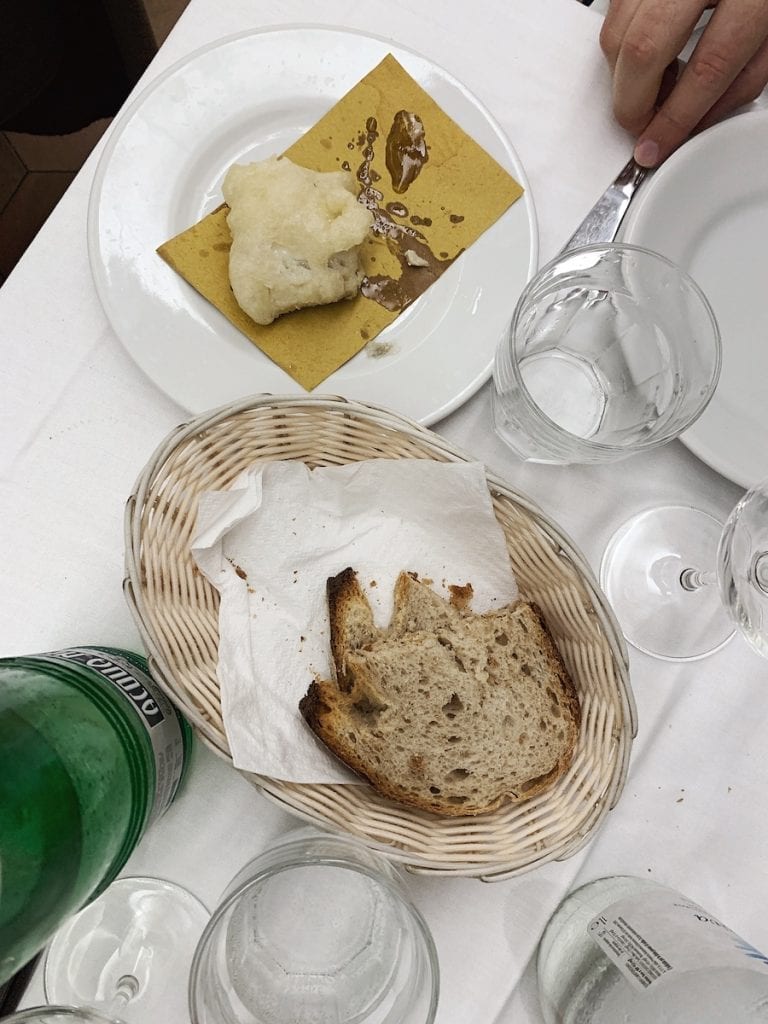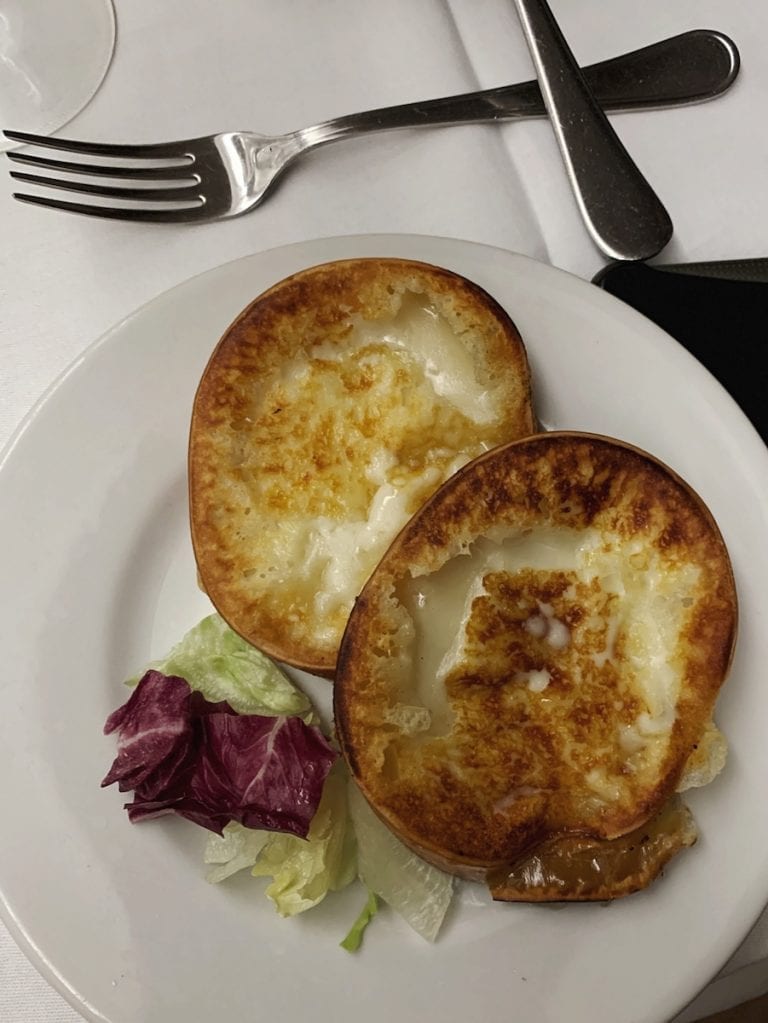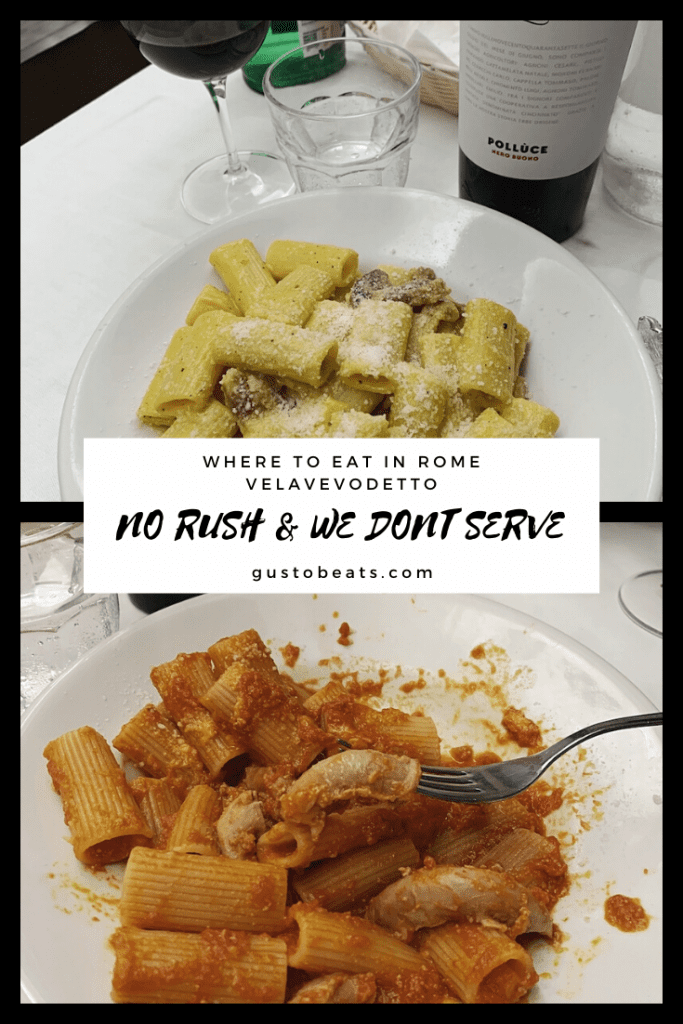How to order food in Rome? This is a post for whom want to know, what to order for authentic Roman cuisine, and what you shouldn't ask from an authentic Roman restaurant like Flavio al Velavevodetto!

Last week, we went out for a spontaneous dinner with a friend from Milan. As usual, we presented our hospitality by picking up a traditional Roman restaurant. Before I jump into today’s topic: How to order food in Rome, I’ve got a small tip first.
In Rome, if you want a nice and authentic dining experience, booking is always highly recommended. Because, when Google tells you the restaurant is open, it might still be close when you arrive. If it is open as Google, you might be the first unlucky one on a waiting list, even it’s a random Wednesday night!
Testaccio neighborhood has the reputation of an authentic dining area in Rome among the locals.
That night we headed to Flavio al Velavevodetto which is a traditional restaurant with an inconvenient location. We took the metro to Pyramide from Termini, then walked 5-10 mintues there. On our way, we didn’t encounter more than 5 persons and the time is before the dinner, considered as early for the Italians! We dined in the grotto-like area.
The menu is absolutely THE perfect self-portrait of an authentic Roman restaurant, which we find it super entertaining. Flavio al Velavevodetto is 100% a good example to show us a few tips of how to order food in Rome.

"NO RUSH"

"WE DON'T SERVE..."
Alfredo style / Bolognese style / Lasagna
Spaghetti with meatballs?
Cappuccino?
OK, so how to order food in Rome, if we cannot get those “Italian” dishes we know? Velavevodetto shows a good example as they've got almost all the traditional dishes, in a pretty professional way!
Spaghetti with meatballs / Fettuccine Bolognese style
Choice 1: Bucatini all’Amatriciana
A lot of traditional Roman dishes are tomato-based, and the Central Italy is never a place for vegan dishes.
In Rome, one of the most traditional pasta dish is Bucatini all’Amatriciana. In Italian, “Buco” means hole. So, we imagine Bucatino is a pasta with a hole – let’s say like a tube. It is said, this shape is easier to cook and to grab more sauce.
Amatriciana, is a type of sauce with tomato, pecorino cheese from Amatrice and guanciale (cured pork cheek) from Rieti (province of Lazio region) originally. Now you will find it a bit spicy because many make this sauce with black or chili pepper.
Choice 2: Rigatoni con la Pajata
Rigatoni is a pasta from Central and Southern Italy. It is like a big brother of penne. With the very traditional Pajata sauce, its name is Rigatoni con la Pajata, which is the most traditional Roman dishes. Pajata, is the intestines of the calf only when it still feeds on its mother’s milk. The intestines have to be well skinned, cleaned, and stewed in the typical tomato sauce. The creamy consistency with the good balance from the acid tomato sauce, is the key to this dish. Unfortunately, I don’t see this dish much in Rome.

Fettuccine Alfredo Style
Carbonara
It is the most well-known Rome pasta. Carbonara is what you must try! Bacon, cheese, egg and pepper is the major 4 ingredients for Carbonara. However, you can have a few choices of different pasta. They are fettucine, spaghetti or rigatoni. Here in Velavevodetto, they make with rigatoni.
The origin of Carbonara is not 100% clear, however, there is a mainstream theory I found it creditable and interesting. Carbonara, the name derived from “Carbonaro”, which in Italian words, means charcoal burner. Probably, this word refers to the working class with charcoals, or they are miners. Guess what? They all love Carbonara!
The second theory is related to an American-Italian chef in the time of the Italian immigration to America. The Italian Chef didn’t want to waste those “left-over” bacons, eggs, and cheese from the American’s breakfast. So, he invented the Carbonara by mixing those “breakfast” ingredients with the Italian pasta!
A good carbonara will never be milky white. Instead, it should be in gold-yellow color with many black dots (the peppers). You might find it very different from the “Carbonara” outside Italy, because many restaurants make it with cream sauce (absolutely not acceptable). The ingredients are so simple that I imagine it as an easy home-made dish. Truth is I’m naïve. I can always make a Carbonara edible and fairly tasty but never presentable as those from the good restaurants.
Cacio e Pepe OR Gricia
You might notice in Rome, Carbonara has a few “cousins”, which might be confusing when you have to order.
Cacio e Pepe, means cheese and pepper literally. Normally, it is the spaghetti with pecorino cheese and black pepper. It is very similar to Carbonara but it’s without eggs.
Another non-egg “cousin” is Gricia, which is an ancient Roman dish since 400 AC. The main ingredients are guanciale (cured pork cheek), pecorino cheese and black pepper. You can find also in Velavevodetto.










14 Responses
First, now I want Italian food. Secondly, I had no idea about not ordering a cappuccino after a certain time. Great info!
haha, I dont know the cappuccino rule either at the beginning, but anyways, I’m taking my advantage as being a foreigner (Asian face in Rome), and I still (sometimes) order cappuccino whenever I want! Not all the bars/cafes will accept, but few tourist place and a few laptop-friendly cafe (international cafe) will not have a problem with my request.
All of this looks SO good. ?
Find more foodie friends to go with you when visiting Rome, then you can taste all 🙂
haha
Your post made me laugh ? You are so right about the no rush! Thank you for sharing this post!
You’re welcome 🙂
About no-rush, it’s really “annoying” me sometimes, coz few are too slow! And, as an Asian, I’m so used to efficient and quick…..
It sounds like dining in Rome is difficult.
Well, not really, coz Rome is a city where you can find (always) a place to eat.
But, I think for non-locals, the problem is to tell the good ones from the tourist-oriented ones. And also, personally, I always think, visiting a place, means you eat like a local, and to find a really good authentic Roman restaurant in Rome, especially talking about in Rome city centre, would be absolutely not an easy task!
That’s why, need us, blogger 😀
Yes, Italians don’t like to be rushed with their food. I love the sign of what they don’t serve, too funny, because I’m sure they’re sick of people asking for these dishes. I am of Italian background, and I sometimes have ordered cappuccino in the afternoon in Italy; they may grumble, but they still make it for you.
haha, that’s very much true!!! To be honest, after so many people telling me “not to order cappuccino”, I haven’t tried, well, maybe I shall then observe the reaction of the guy in the bar, that must be funny 😀
Haha… Honestly, while I was reading your article I was smiling the whole time.
I have a similar post ready to go viral, however, it’s slightly different… But I love to read these things from other bloggers. Happy to find writings that really dig into the Italian culture, to help others understand this amazing country better.
I would love to read that post you mentioned!!!! I’m always curious about culture stuff, coz Italians are so different from Chinese hahaha
somehow, I find them funny in their way!
I saw you DM, let’s talk there :3
HAHA this is hilarious and I love the brutal honesty of the restaurants. And to be fair it’s exactly what you said. It’s their style and culture and you better like it because if you don’t you’ll miss out on some excellent Italian cuisine.
yea! It’s great to hear the same voice here! Exactly! I think one of the most impressive way to know a place and its culture is, to eat their food (typical from a foodie)